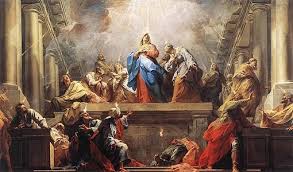The first Christian Pentecost was a feast of fulfillment. It was, in a very real sense, a graduation ceremony in which twelve simple men from various walks of life became prophets, preachers, priest, prodigies, and polygots. A feast of fulfillment because they became what they were destined to be. Removed some 2000 years from Pentecost, it is, for us, a feast of possibility. The Holy Spirit is ever ready to pour out His power on each and every believer. The problem though is that the average believer is not ready to receive His power. Part of the reason for this is that we view Pentecost as an isolated event; a miracle for sure but not magical. The Apostles were ready to receive the fullness of the Holy Spirit and in so doing, left for us a model of preparation that we need to follow.
Protestants would have us to believe that union with the Holy Spirit comes about through faith, that is, by a single moment of conversion. Sacred Scripture and the Mystical Doctors of the Church teach otherwise. They teach, each in his or her own way, that three conversions are necessary for union with the Holy Spirit. One of them, St. Catherine of Siena, shows how the Spiritual life of the Apostles reveals the content of these three conversions which culminate in the fullness of the Holy Spirit on Pentecost.
As in all activity, our spiritual lives are marked by three levels of maturity—beginners, proficients, and perfected. These three stages are clearly delineated in the Scriptural account of the lives of the Apostles and therefore serve as a model for each of us. St. Catherine in her Dialogue traces each of the three conversions of St. Peter and enables us to see some of the qualities of each in order to facilitate our own growth towards union with God.
St. Peter and the Three Conversions
The first conversion happens when St. Peter acknowledges he is “a sinful man” and Our Lord promises to make him a “fisher of men”. From that point forward, St. Peter set out on what St. John of the Cross calls the Purgative Way. This is the most active of the stages in that we must, under the instigation of actual grace, remove all the obstacles to true growth. For St. Peter, this purgative stage lasts almost the entirety of the pre-Passion and Resurrection accounts in the gospels. It also helps to explain why St. Peter shows such incredible flashes of sanctity while also being called “Satan”. St. Peter will remain in this stage until he is no longer scandalized by suffering and is willing to mortify himself completely. Even during the Trial of Jesus, he keeps the suffering Christ at a distance and therefore fails to admit to even knowing Him. He loves Jesus, but not more than he loves himself.

It is just after the three-fold denial that St. Peter experiences his second conversion. When Our Lord gazes upon Him just after his third denial, He receives the grace of deep sorrow for his sin. St. Peter’s second conversion occurs when he has him “come to Jesus” with Our Lord on the shore of the Sea of Galilea with his three-fold affirmation of his love for Jesus. In loving Our Lord “more than these” St. Peter is no longer deterred nor scandalized by the fact that he will have to suffer. Each of his affirmations, according to Fr. Garrigou-Lagrange, marks each of the three distinct motives for the second conversion. We find the juxtaposition of the two Greek words for love—love of friendship (philia) and love of God (agape)—in the dialogue to mark the rooting out of all traces of self-love by a desire for Divine friendship and filial love of God. Secondly, Peter is aware of the great price of Christ’s Blood. Third is the love of souls that need to be saved in his desire to “feed my sheep.”
Furthermore, he must first go through the Night of the Spirit where he no longer is aware of Christ’s continual presence. He only “feels” His presence on a few occasions and loses it completely when Our Lord ascends into Heaven. Just as in the transition from the first conversion to the second there must be a purgation of the sense, a purgation of the spirit must be undergone in order to pave the way for the third conversion. It would seem that the Apostles were on the fast track in that they only had to endure the Night of the Spirit for 50 days, until we put ourselves in their sandals and realize how painful it must have been for them. They had spent three and a half years, day in and day out, with the constant awareness of God’s physical presence.
All of this leads up to the third conversion on the day of Pentecost. Our Lord had meticulously been leading St. Peter to this moment when he would be united to God in the fullest sense possible on Earth. He still was not perfected, but he was closely yoked to God in the Unitive Stage. What we need to focus on is that Pentecost was not just an isolated event in their spiritual journey but the culmination of it. He, along with the other Apostles, received the Holy Spirit because they were ready for it.
All of this talk of the need for a “New Pentecost” is really a call for more saints who have the courage to set out through the Dark Nights and to be so purified as to become completely united to the Holy Spirit. Without the proper preparation work this “New Pentecost” will never happen. With the path of the threefold conversion the Apostles have left us along with the instructions of the great Mystical Doctors of the Church, we “shall renew the face of the earth” and share in the fruits of the same Pentecost that marked the birth of the Church.

